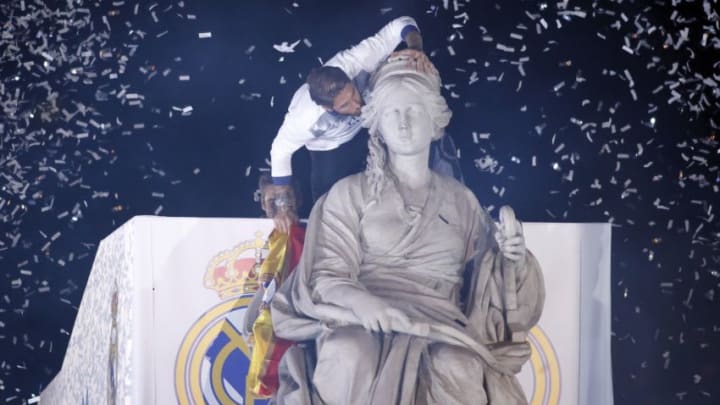After sealing a 33rd La Liga title, the Real Madrid team and staff headed for the Cibeles Fountain where they celebrated with the fans. The pictures of Madrid fans gathering at the Cibeles is a familiar one, no matter what trophy, the first stop is always the Cibeles. This prompts the question, how did this fountain become one of Real Madrid’s most important symbols?
The History of Cibeles Fountain
The Plaza de Cibeles has a history that pre-dates the existence of Real Madrid as a football club.
The Cibeles fountain dates back to the 18th century when Ventura Rodriquez sketched the first plans for the statue. The sketches depicted the Greek goddess Cybele in a chariot pulled by two lions. The image was inspired by an Ancient Greek myth. It was constructed by a team of sculptors.
The goddess was designed by Francisco Gutierrez, who also did the chariot’s wheels. Roberto Michel did the lions and Miguel Jimenez was left to add details to the final structure. It was placed at the intersection between Buenavista Palace, Linares Palace, the Bank of Spain and the Communications Building.
The fountain was used as a meeting point for water carriers until water was piped to houses. It survived the Spanish Civil War unscathed as it was covered in sandbags for its duration.
First Appearance in Spanish Football
The Cibeles introduction to Spanish football came in a rather surprising manner. In 1953, Atletico Madrid was celebrating their 50th anniversary. They decided to organize a competition with their father club, Athletic Bilbao. The prize for winning was a trophy featuring the Cibeles statue. In 1977, Real Madrid celebrated their 75th anniversary with a four aside football tournament.
The occasion was rather downbeat, Santiago Bernebeu was sick, the fans hated head coach Miljan Miljanic and perhaps worst of all they were struggling in Europe. At the reception, the mayor of the Madrid presented Santiago Bernabéu with a sterling silver replica of the Neptune fountain. The Neptune fountain is less than a mile away from the Cibeles and is now where Atletico Madrid fans celebrate their title victories. It wasn’t until 1986 that the Cibeles began to be associated with Real Madrid.
Spain 5-1 Demark
Spain reached the first knockout round of the 1986 World Cup. Their coach was former captain and Real manager Miguel Muñoz and the spine of the team consisted of Real Madrid’s Quinta Del Buirte. Their opponents were Demark, a side with a reputation for scoring and conceding goals.
The Danes were tipped for the world crown in 1986, In contrast, the Spanish team was quite average, their performances hadn’t impressed and the Quinta were new to Spanish and international football. Despite being underdogs, Spain shocked the footballing world running out 5-1 winners, a young Emilio Butragueño scoring four goals.
In Spanish fiesta style, the victory sparked joyous celebrations in Madrid. Fans headed out to celebrate and some began to gather around the Cibeles fountain and bathing in the water. The distinct Madrid flavor to the squad meant that Spain’s victory felt like a Real Madrid victory.
Bayern Comeback and The Cibeles
During the 1987-1988 season, Real Madrid made an impressive run to the European Cup semi-finals. In the quarters, they had lost 3-2 to Bayern Munich away but made a comeback in Madrid, winning 2-0.
More from The Real Champs
- Manchester City hold talks over Real Madrid target
- Real Madrid player confirms he is playing with a fracture
- Real Madrid superstar rejected Premier League clubs confirmed
- Spaniard ready to join Real Madrid instead of Liverpool
- PSG want €100 million Real Madrid player to replace Kylian Mbappe
Madrid fans were overjoyed as Bayern had beaten them the season before. That night, the celebrations of Spain win over Denmark fresh in their minds, Madrid fans went to the Cibeles to celebrate their victory.
Since that comeback win against Bayern, Madrid fans have continued to flock to the Cibeles to celebrate big wins or titles.
As for Atletico Madrid, they had to settle for Neptune’s fountain where they celebrated their league and cup double in 1996 and have continued to celebrate big victories there ever since.
